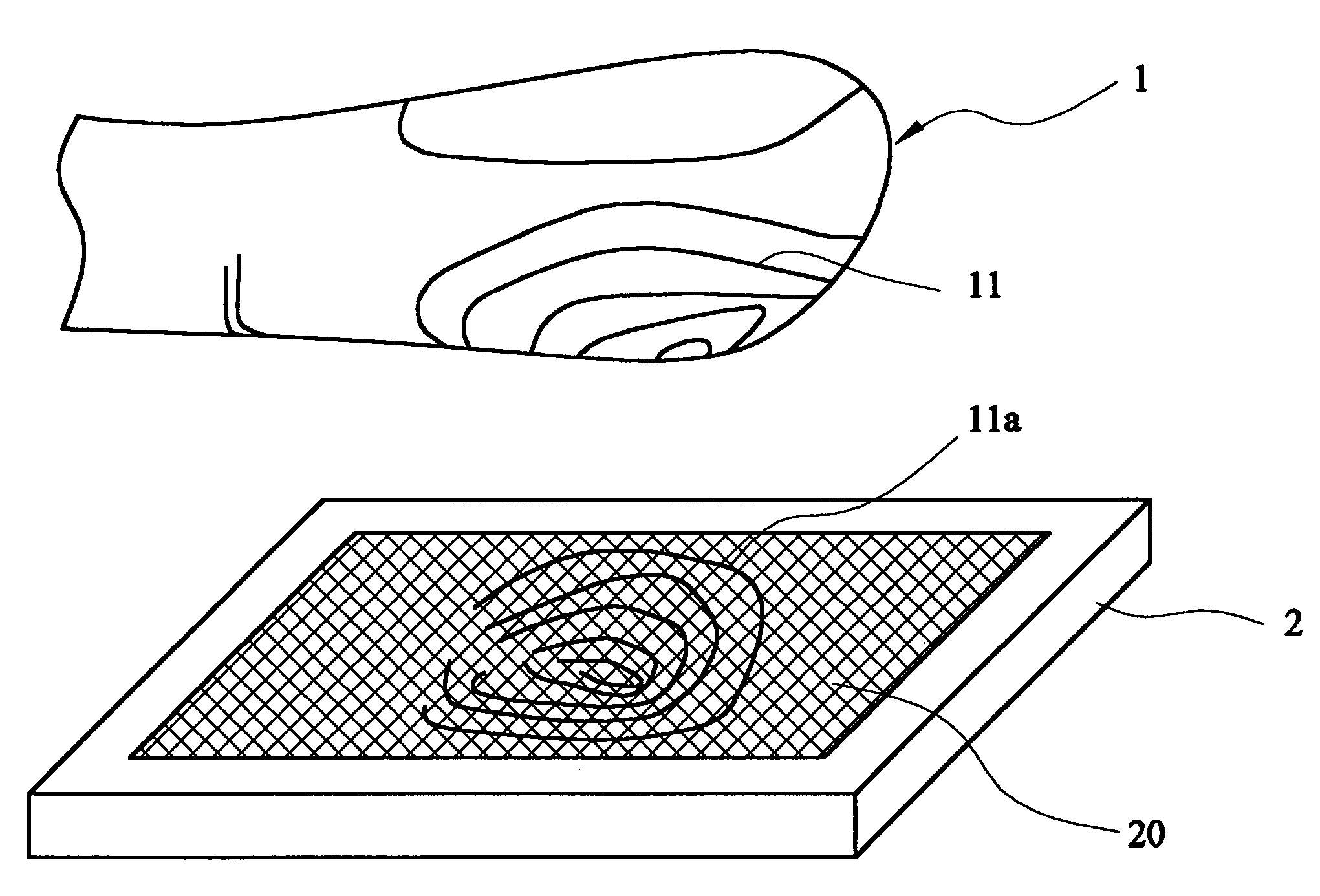Chip-type sensor against ESD and stress damages and contamination interference
a sensor and chip technology, applied in the direction of resistance/reactance/impedence, instruments, measurement devices, etc., can solve the problems of inability to withstand esd damage or force impingement, inability to resist esd damage or stress damage, and inability to crack, so as to effectively avoid contamination interference, enhance the sensing effect of the sensor, and prolong the life of the sensor
- Summary
- Abstract
- Description
- Claims
- Application Information
AI Technical Summary
Benefits of technology
Problems solved by technology
Method used
Image
Examples
first embodiment
[0032]FIG. 2 is a partially schematic side view showing a capacitor sensing member of FIG. 1 according to the invention. As shown in FIG. 2, the capacitive fingerprint sensor of the invention includes a silicon substrate 21, a plurality of sense electrodes 22 (only one electrode is shown in the drawing), and a protection layer 26. The silicon substrate 21 contains a sense circuit 21A corresponding to each sense electrode 22, and includes a signal processing / control circuit 21B (schematically shown in FIG. 4) around the sensing member array, wherein the detailed arrangements of the sensing member array and the peripheral circuit may be found in the above-mentioned disclosure entitled “CAPACITIVE FINGERPRINT SENSOR”. The sense electrode 22 is positioned on the silicon substrate 21 and is electrically connected to the sense circuit 21A, wherein the portion below the sense electrode 22 and including the sense circuits 21A, the signal processing / control circuit 21B, and the silicon subst...
second embodiment
[0037]FIG. 3 is a partially schematic side view showing the capacitor sensing member of FIG. 1 according to the invention. Referring to FIG. 3, in addition to the above-mentioned sandwich structure, the protection layer 26 further includes a fourth layer 26D applied to the third layer 26C so as to provide a hydrophobic and lipophobic surface to be in contact with the finger and prevent the latent fingerprint from being formed thereon. In one embodiment, the fourth layer 26D is a polymeric material which is made of Teflon or Teflon-like chemical structure. Alternatively, the polymeric material layer 26D is formed on the third layer 26C using a polymeric monomer solution, which has monomers, a fluorocarbon (FC) polymer end, and a polar silane group. The FC polymer end is exposed to the outside and has a soft fragment FC polymer bond for protecting an integrated circuit from the external contamination. The polar silane group is for firmly fixing the polymeric material layer 26D to the ...
third embodiment
[0044]FIG. 8 is a schematic top view showing a capacitive fingerprint sensor according to the invention. The sensor of FIG. 8 is similar to that of FIG. 7 except for the difference residing in that each ESD unit 24 of FIG. 8 is only adjacent to two sacrificial electrodes 22S. That is, each of the two adjacent plate electrodes 22 sacrifices a region to be used by the ESD unit 24.
PUM
| Property | Measurement | Unit |
|---|---|---|
| thickness | aaaaa | aaaaa |
| thickness | aaaaa | aaaaa |
| thickness | aaaaa | aaaaa |
Abstract
Description
Claims
Application Information
 Login to View More
Login to View More - R&D
- Intellectual Property
- Life Sciences
- Materials
- Tech Scout
- Unparalleled Data Quality
- Higher Quality Content
- 60% Fewer Hallucinations
Browse by: Latest US Patents, China's latest patents, Technical Efficacy Thesaurus, Application Domain, Technology Topic, Popular Technical Reports.
© 2025 PatSnap. All rights reserved.Legal|Privacy policy|Modern Slavery Act Transparency Statement|Sitemap|About US| Contact US: help@patsnap.com



